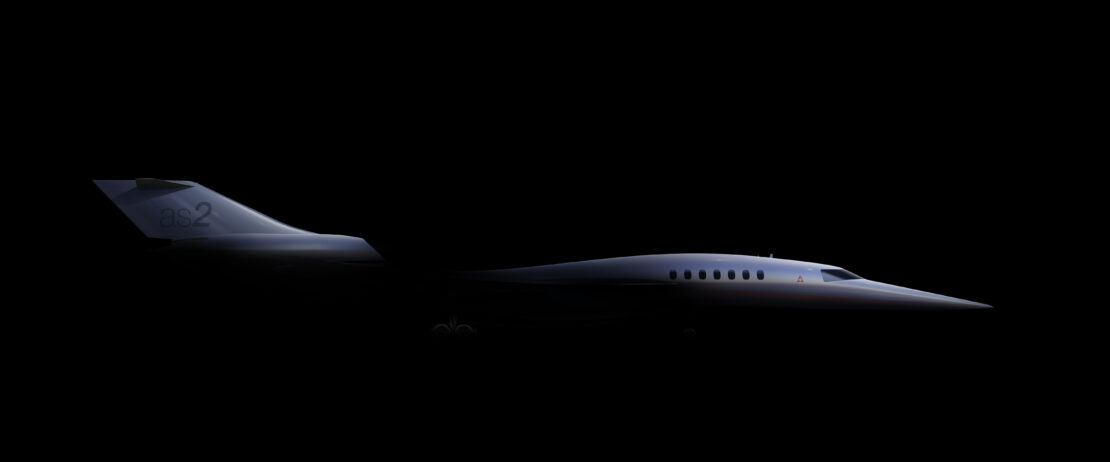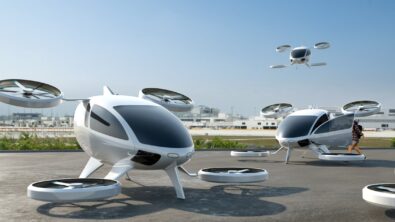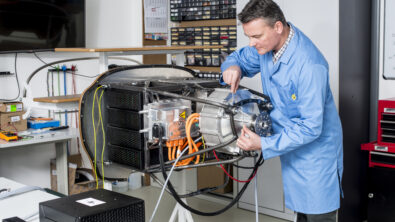“Zero-emissions” podcast series: cleaner, greener propulsion systems in the era of advanced air mobility – ep. 1 Transcript

Welcome to Season #5 of Talking Aerospace Today. This first episode of a five-part series discusses zero-emissions aircraft and how it applies to urban air mobility vehicles, eVTOLS and our more traditional wide and narrow-body aircraft. We cover a lot of ground, and it’s an excellent introduction to the series.
Read the transcript below of my discussion with Dale Tutt or listen to the podcast.
Read the podcast transcript:
Scott Salzwedel: Hello, this is Talking Aerospace Today, a podcast for the aerospace and defense industry. A place that brings the promise of tomorrow’s technology to the ears of our listeners today.

I’m your host, Scott Salzwedel. Welcome to our new five-part series “The Future of Air Mobility: Zero Emissions Aircraft.” This promises to be a fascinating series as we explore new ways the aerospace industry can deliver cleaner and greener propulsion solutions, so very important. To be more energy-efficient, we’re going to talk about how companies can solve the design challenges that lie ahead. Major change won’t come overnight, but already we’re seeing an incremental change in fuel efficiency and sustainable fuels. I’m pleased to introduce my special guest, Dale Tutt, who is Vice President of Aerospace and Defense at Siemens Digital Industries Software. Welcome, Dale. Thanks for stopping by.
Dale Tutt: Hey, Scott. Good morning. And it’s really great to be here today, and I’m looking forward to our discussion.
Scott: And it’s always a pleasure to have you, we just have such wonderful discussions, such great topics. And thanks again for being here.

Dale: Well, we just keep finding all these great topics to discuss. We really get after it, we have some great conversations, and sometimes have a lot of fun, to be honest with you, and I’m so pleased to be back for a fifth season with you on this.
Scott: I totally agree, Dale. There’s no stopping us now. Okay, so let’s get started. Thankfully, at this time in 2021, commercial air travel is starting to gain momentum as we get back up to speed. What is the industry doing to prepare for a greener future in air mobility?
Dale: It is good to see that the airline industry is starting to pick back up again and that we are starting to make progress and that’ll be good for everyone in the industry. And we’re pleased to see that. But in the last couple of years, there’s been a lot of discussion about improving the overall emissions and going into zero-emissions aircraft, a lot of investment there. But before that, and you look back over the last even 10, 15, 20 years airlines and the manufacturers of airplanes have been doing a lot to reduce the fuel emissions. They’re trying to get better efficiency of their aircraft as well as just better fuel economy to really reduce the amount of fuel that is being used during the flights. And that also obviously improves the cost structure as well. But it’s more environmentally friendly and it takes less oil from the ground. And so, the industry has been looking at fuel efficiency and reducing emissions for more than a decade now.
Scott: Okay, great. So, what measures do airlines have to take to accommodate? We talk about these different fuel blends, I’m sure it’s not a straightforward process, something has to happen to accommodate these fuel blends.
Dale: As you said, we’re starting to look at different blends of fuel. So, not just burning pure jet fuel anymore, but looking at some of the synthetic or the biofuels, the more sustainable aviation fuel blends. And a lot of times what these fuels are, is they’re a mix of jet fuel with biofuel mixtures, and maybe it’s like a 50/50 mix. And so, when you start looking at different fuel systems or different fuel blends, sometimes you have to look at changes to your fuel system, the types of gaskets or seals that you might use, you have to look at the changes to the materials as well as to the fuel-air mix inside of the engine. And so, companies when they start looking at different fuels, they have to look at how the airplane is designed and how the engine is running when they’re looking at these different fuel blends.
Scott: I do believe there’s already an initiative in a place called sustainable aviation fuels or SAF. So, does SAF help with the retrofits?
Dale: Absolutely. And I think as I said since it’s not a pure biofuel, it’s a blend of about 50 percent jet fuel and 50 percent biofuel. And the benefit of this is that it burns similar enough to the current fuels that they don’t have to make as many changes to the fuel systems, they don’t have to make as many changes to the engines. And so, it gives the airlines some flexibility to be able to burn different kinds of fuels. And so, it really has made a difference. I think when you look at some of these blends like the sustainable aviation fuels, they’re seeing in some cases that they’re reducing hydrocarbons over 80 percent of the lifecycle of that fuel. So, it does make a difference when you start burning it and it is being done. They’re using a lot of waste products in some cases, and it’s being done in a much more sustainable way. And so, it shows great promise in the near term to reduce the amount of oil usage as well as reducing the amount of emissions they have.
Scott: We’re going to talk about zero emissions in just a minute, but this is such an important topic and really zero emissions that’s a little bit out there. But it’s important for our listeners to understand that aircraft companies and OEMs are doing a lot right now today to improve fuel efficiency and emissions.
Dale: There really has been a lot of incremental progress on improving fuel economy and reducing emissions over the years. And we see this in advancements in the engine technology that the newer engines are much more fuel-efficient; just changing the engines out, you get a benefit but then you start to look at some of the newer airplanes like the 787, the Boeing 787, is a great example. And I think at the time, they were saying that it was going to be 30 percent more efficient than some of its predecessors. And that’s pretty significant when you think about some of these long routes that these airlines are flying on, if you’re improving the fuel efficiency by 30 percent, that’s a pretty huge improvement. And they did it through a combination of things. They looked at how did they improve the aerodynamics of the airplane to make sure that they have better airflow over all the surfaces that they had less drag; they looked at more electric aircraft systems, so they replaced in some cases a traditional mechanical system, such as a pneumatic system with an electrically driven system, so that they weren’t pulling bleeder off the engines, and they weren’t extracting mechanical energy off the engine in the form of a hydraulic motor. So, this is pretty important when you think about it. When you’re extracting energy off of the engine in the form of a generator, the electrical generator might be 93 percent efficient, and you have very good efficiency of electrical systems, whereas the mechanical systems, maybe that’s like 70 percent efficiency, and so you get a nice increase in the efficiency of the components of systems on the airplane, and that results in less fuel being burned for that particular mission. And then I think just generally, as I mentioned earlier, the engines just being a lot more efficient burning fuel, they’re getting 10 to 20 percent more efficient than they were a couple of decades ago. So, you continue to see advancements in all three phases of flight – the aerodynamics, the systems on the aircraft and how they’re using energy, and the engines themselves.
Scott: That sounds wonderful. So, we are getting there slowly, but surely. You mentioned Boeing, and I just thought of the press release issued earlier this year around a whole new aircraft; I guess they’re calling it the 5X project. So, I’m wondering if you’ve heard anything about this new project. And also, I would hope there’d be some new innovations regarding fuel emissions with this new aircraft. I’m not sure if you know what’s going on, but wow, this is a promising thing to look forward to.
Dale: A couple of years ago, Boeing was looking at a new mid-body aircraft, and they were looking at developing a new airplane and that was put on hold. But there’s been some discussions, there’s been a few press releases about the fact that they are looking at developing a new aircraft. And they’ve obviously not released any details yet for competitive reasons, but I think it’s safe to say, like many of the past Boeing programs and past Airbus programs that you will see advancements in fuel economy, fuel emissions, that they’ll look to take it to the next level over what they’ve achieved in the last decade or so with some of their aircraft design. So, yeah, certainly that. And then the other thing we’re going to see is that they’re committing to burning more of these sustainable aviation fuels as well. And so, it’ll be a mix of both is how they’re designing aircraft as well as the fuels that they’re burning.
Scott: Alright, so let’s talk about zero emissions. It’s not happening overnight, it seems to be a slow process. So, what’s the hang-up? Why this 5 to 10 year horizon?
Dale: Yeah. And actually, it might even be a little bit further than that. Sometimes they talk about 2040 or 2050 before some of these new products come online or a new aircraft come online. There’s a couple of reasons for that. One is the airplane design itself needs to change. And so, when you start thinking about a hydrogen tank on the airplane, it’s usually going to be under high pressure, and it’s going to be round, and maybe you are looking at cryogenic storage. There are just many different factors involved with the aircraft design and it’s not just changing the engines and it’s not just changing some of the systems on the airplane, but it can really be a pretty radical design change to the airplane. So, even though it might look the same on the outside, the inside might be very different. So, that’s going to take time to develop. And then the other thing is the infrastructure itself is going to have to change. All of the airports have to be retrofitted, they’re going to have to change. The entire infrastructure that we have has been developed over the last 100 years and it’s based on jet fuel. And so, all of your storage tanks, all the delivery systems throughout the entire airport are really built upon a jet fuel-based system and that structure is going to take time to develop. And so, they need to find solutions for the airplane’s designs, and at the same time, they need to be working on the infrastructure needed to support that. So, it’s going to take time, but we’ll get there and it might actually happen faster than we think.
Scott: That’s great news. Great news. Okay. So, when you get down to it, there really are just two paths to follow when it comes to zero emissions, electric/hybrid propulsion, and then hydrogen. The electrical vertical take-off and landing vehicle and the urban air mobility segment show a lot of promise when it comes to zero emissions.
Dale: Yeah, Scott, they really do. It’s very exciting when we think about the eVTOL, or the air taxis and the ability to fly above the gridlock when you’re going say to the airport or going across town. But there’s also the electric aircraft, some of the aircraft like Bye Aerospace that they’re developing for many different mission sets. I just saw a story today where they’re developing now an eight-passenger electric aircraft that can go 500 nautical miles. And that’s super exciting to me. But when you think about the changes you have to do with these airplanes that you’re putting on the electric motors, now all the systems have to be electrical, and then you have to be able to manage the batteries and the weight of the batteries and storage. And so, it does bring a new set of challenges both to the design of the aircraft, to the certification, as well as to the maintenance of the aircraft. It brings a lot of promise and I’m very excited about the future there with these aircraft, but there are some new challenges.
Scott: Exactly… so when we talk about the eVTOLs, design teams need to weigh the issues between energy density and power density. And we hear that all the time, so if you could for our listeners explain energy density and power density and how those two relate to each other.
Dale: When you look at batteries, a pound of batteries versus a pound of gasoline, a pound of gasoline might have 100 times more energy density, power density than the batteries do. So, the weight of fuel that you carry is much less than the weight of the amount of batteries you’d carry to serve the same mission. And so, you also have a volume constraint that aligns with that, that the more batteries you put on board, the more volume they take up. And again, that brings different challenges than you have with using gasoline, or I should say aviation fuel or jet fuel. So, it does bring different challenges to these eVTOLs and how you have to design the aircraft.
Scott: It’s interesting, we’re talking about electric propulsion, but earlier, we were talking about how electrification on an existing aircraft also saves power. I think we talked about that Boeing 787. So, we really need to make a distinction when it comes to electric aircraft and electrification, there are two really different applications here.
Dale: When you look at the generator, and an electromechanical system, most of those motors that are in that electrical system, they are operating at 90 percent efficiency. So, when you extract 100 horsepower off of the engine, 90 percent of horsepower is going to be used to perform whatever task is required on the airplane. When you convert that to electrical power, so through hydraulic pumps and then through other mechanisms, the energy efficiency or the mechanical efficiency of those may be on the order of 70 percent or 75 percent. And so, when you extract 100 horsepower off the engine, you only get 70 or 75 or 80 horsepower of work out of it, so you get less work out of it. And so, that’s the trade-off for the benefit; when you start looking at these electrical systems, you’re getting a lot more fuel efficiency. And another variation of that is some of these mechanical systems today are actually pneumatic. So, you’re now extracting air off the engine to pressurize the cabin, to heat the cabin, to cool the cabin. And when you’re extracting the air off of the airplane, off the engine, that’s air that’s not being used for thrust so it’s not pushing the airplane forward. And again, it’s a similar efficiency trade-off. It’s less efficient to take the air off and move it around the airplane than to put, say, an electric compressor on the airplane somewhere and use that to pressurize the cabin or to heat the cabin, which is something that they solved on the Boeing 787 when they went to basically an electrically driven pressurization system and heating and cooling system. So, it does really change the dynamic when you start looking at changes to the systems on the aircraft.
Scott: Let’s talk hydrogen. And I have to be honest, to me, it seems like it’s still a very controversial subject.
Dale: Yeah, it is a little bit controversial. I mean, it shows a lot of promise to be zero-emissions because the output of the combustion products of hydrogen and oxygen is water. And so, it’s very attractive, but there are some challenges and there are some people that see it differently. And obviously, one of the challenges is probably public perception. When you think about the use of hydrogen, inevitably somebody might bring up the Hindenburg, which was an airship that was originally designed for helium, but then ended up being filled with hydrogen, and then they had the accident. But that doesn’t mean that it can’t be used as a safe fuel, and it is being used as safe fuel in a lot of applications. But then there are also detractors that look at some of the challenges that we talked about earlier with how you need to design the airplane and the challenges with the infrastructure that feel that maybe it’s a little further off in the distance before we could actually get to a hydrogen-based aviation economy. Then there are also some of the basic facts about hydrogen and jet fuel and the energy density. And when you think about hydrogen, it’s about 100 times the electrical power by pound times electrical power. So, 100 times better, more energy density by a pound in electrical, whereas jet fuel is about 40 times that of an electrical battery. So, by weight, both hydrogen and jet fuel are more efficient than batteries and hydrogen is much more efficient. The volume itself is also an issue. Jet fuel takes about three times the volume of hydrogen, to get the same amount of density, but then it’s about 30 times out of electrical. So, when you think about the energy density, and the volume, and the weight, it does offer different challenges to the aircraft designers. And so, these considerations really affect the range and the size of different aircraft and where you might use some of these different applications for powering the aircraft.
Scott: So, when we talk about hydrogen, there are really just two different applications. The first is hydrogen as a fuel, as you’ve already spoken about, and then the second is hydrogen as a fuel cell battery. Now, can you touch on the advantages and disadvantages of these two approaches?
Dale: Yeah. So, when you think about the first option, your hydrogen is directly the sole source of fuel. There’s a lot of serious talk going on here and this is where some of the investments are being made to take the hydrogen and basically directly run it to the engines themselves and burn the hydrogen. And there are some skeptics there and I think, as we mentioned, it gets around the storage of the hydrogen system and how you’re going to design the fuel tanks and get the hydrogen to the engines themselves. But there are people that are looking at it and working on it. But then when you look at the second option around hydrogen fuel cells, and batteries, some of this technology is still being worked out. And there’s been some demonstrators out there, looking at it on some smaller aircraft. And who knows, maybe it’s 10 or 15 years before we actually see commercial utilization of that. Companies like Boeing, Airbus, various companies have tested hydrogen fuel cell batteries. There’s a challenge with the fuel cells and it’s a bit of a trade-off that the fuel cell wants to be cool, to operate at cold temperatures to be really efficient. But the process of creating electricity actually creates a lot of heat, so the fuel cell heats up. And so, you’re trying to find a sweet spot of what temperature you can operate it at. So, to maintain that balance of good efficiency for creating electricity, and getting the efficiency and the energy off of it that you want. So, they’re both very good options, but still need a little bit of work as we go forward.
Scott: Okay, so dealing with hydrogen, I would imagine there are all kinds of design trade-offs.
Dale: Absolutely. When you think about dealing with hydrogen, you’re going to look at what type of propulsion system you’re going to use. There are concepts out there that use traditional propeller-driven airplanes, some that are using jet engines still, you’re starting to see blended wing bodies, just different shapes of airplanes. There’s a lot of work to be done and understanding how to store the fuel on the aircraft and then you still have the trade-offs like we were just talking about. Are we going to use hydrogen to directly power the engines? Are we going to use it for a fuel cell and generate electricity that then drives an electrical motor? So, really are a lot of different things that we need to look at. And we’ll have to look at the design trade-offs for all of that around range and speed and what altitude you’re going to operate at. And then all these different shapes bring new structural issues and structural challenges or with different material requirements. And you have to look at the flutter of these shapes, and you have to look at the thermal management of all these electrical systems on the airplanes. So, as an aircraft designer, when you think about the aerodynamic shape and the aerostructures, the design of the structures as well as the design of the systems and the management of all those systems, it really does bring a lot of interesting trade-offs into play as you design the airplane.
Scott: Man, I would imagine there’s just so much complexity and so much integration going on. And also, so many activities that need to happen concurrently. It’s just mind-boggling.
Dale: Yeah, it really is. And I think you’ll see some of the fundamental model-based systems engineering principles start to take the lead here, where you’re looking at the different scenarios where you’re going to fly the airplane, and you’re looking at the overarching system of systems where it’s the airplanes operating in the environment, the airspace, and the infrastructure requirements for the airlines in the airports that you see. So, this is a big systems of systems problem. How you solve one problem, it has influences on the other. And then as you get into the aircraft design, there are so many different factors in terms of how you design the airplane that becomes very challenging. So, as you go through this, using model-based systems engineering with a good digital thread, where you have that traceability from requirements into your system models and into your product designs, and then even how you design, develop, and manufacture the products as you go forward, there’s a lot of tools in place now to really help companies and teams go through these challenges very quickly.
Scott: Sure. So, I would imagine, no matter what type of propulsion, teams are going to need some kind of digitalized environment to cover all facets of design and test and development and manufacture. And so, really, we’re talking about a comprehensive digital twin and digital thread, both of them being applied here.
Dale: When you think about how do you solve these challenges, you have to have a rich, robust understanding of your product and how it’s going to operate and how it’s going to perform in the environment that is performing in, how you’re going to build it, how you’re going to ramp up your production rates, produce quality products, and then how you’re going to support it over the next 50 years. These airplanes have long life cycles. And so, when you think about this need to understand your product, your production, and your product support, this is really where the comprehensive digital twin that we have with Siemens, with the Xcelerator portfolio. Having a comprehensive digital twin that rich, robust understanding is going to be critical to being able to evaluate all the different options that are out there when you start thinking about these new aircraft designs. And so, it really does play a major part in the ability for companies to move forward with confidence in a very innovative environment right now.
Scott: Exactly, exactly. Well, Dale I have some very unfortunate news. We’ve already run out of time for this episode, but I really do thank you for stopping by today.
Dale: Wow, that’s hard to believe it’s gone by so quickly. And we have so much more to say here as we go forward, I’m looking forward to it.
Scott: Yeah, definitely. Well, here’s the good news. This is our first episode, we have four more episodes left, I’m sure we’ll get a chance to talk about some really cool stuff. So, just for example, in Episode Two, we’ll cover model-based systems engineering, and how that’s become the backbone to getting things done. And then in Episode Three, we’ll talk about product design and engineering, Episode Four touches on program management and execution. And then our final episode, we’ll wrap this series with the latest in intelligent manufacturing and supply chain management.
Dale: Wow, that’s some pretty cool stuff there. Am I going to be invited?
Scott: Dale, come on… of course you’re invited! See, it is time to stop the show. Okay, so, at the top of the show I mentioned this is a five-part series and if you’ve enjoyed this episode and you’d like to listen to future episodes, please subscribe to Talking Aerospace Today on Apple iTunes, Spotify, or wherever you go to get your favorite podcast. That way, you won’t miss a single episode. You can also check out the links in this podcast description.
My name is Scott Salzwedel and this has been Siemens Talking Aerospace Today. I hope you enjoyed the show, and that you’ll join us again for our next podcast. Until then, bye for now.


